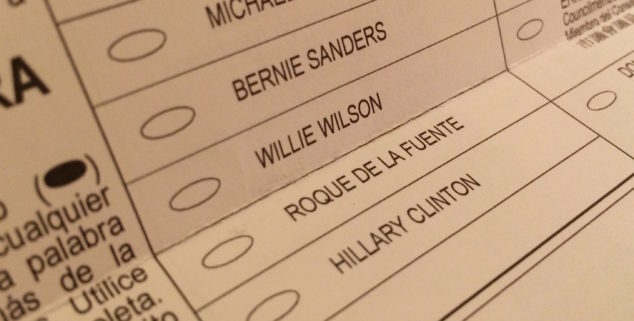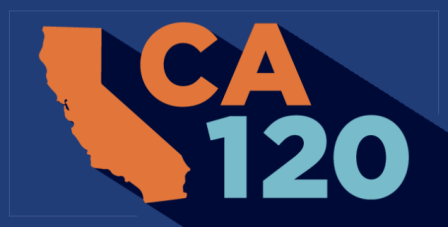Analysis
CA120: Nonpartisans in a pickle
 A portion of California's June 7 ballot. (Photo: Tim Foster/Capitol Weekly)
A portion of California's June 7 ballot. (Photo: Tim Foster/Capitol Weekly)A CA120 article recently shed light on a hurdle facing nonpartisan voters in California’s June 7 presidential primary election. These voters are eligible to participate in the Democratic primary, but confusion is lurking, particularly for mail-in voters.
As a part of that story, we conducted a poll of nonpartisan voters asking if they wanted to participate in the open Democratic primary, re-register to participate in the closed Republican primary or sit out the Presidential contests entirely. Given these choices, two-thirds of voters stated that they wanted to vote in the Democratic contest.
Shockingly, 85% of the nonpartisan ballots were being mailed to voters with no presidential contest on them.
But it is what came next that raised some eyebrows.
When nonpartisan voters were asked how, exactly, they were going to get a Democratic ballot, we saw evidence of widespread confusion.
More than 60% of those surveyed either incorrectly thought that the Democratic candidates would be on their ballot — just like other open primary contests — or said they weren’t sure how to vote in the Democratic presidential race. 
This meant that just weeks before California’s absentee ballots were to be mailed out — and after every absentee voter in the state already had been mailed instructions for how to get a partisan ballot — most nonpartisan voters were unaware of the hoops they had to jump through in order to participate in the presidential contest.
When ballots were sent to voters, we began building a database of those who had requested these partisan ballots. This type of data helps the presidential campaigns, and it allows down-ticket campaigns to identify nonpartisan registrants who are actually partisan Democratic voters.
Statewide, there are 2.2 million voters who vote by mail and are nonpartisans qualified to vote in the Democratic presidential contest. Yet, shockingly, 85% of the nonpartisan ballots were being mailed to voters with no presidential contest on them. And this percentage was even lower among younger voters and Latinos.
Click here to see our list, updated daily, of absentee ballot returns.
To date, we have had over 1.6 million voters cast ballots for the June Primary. Of these, 235,000 are non-partisan voters, and 145,000 were mailed in without a partisan presidential ballot.
As this table shows, there are considerable county-by-county differences in the numbers and proportions of nonpartisan voters who obtained partisan ballots. This could speak to each county’s process, or the kinds of voters in different parts of the state.
But, either way, this document shows a remarkably low rate of partisan ballot requests from a population that, as we have found in our voter research, overwhelmingly wants to participate in the Democratic primary.
This data resulted in significant media attention and a lawsuit seeking to extend the voter registration deadline.
At this point, California voters have only a few options:
–They can mail in a signed request for a Democratic ballot by Tuesday, May 31, and hope to get their absentee ballot returned in time to vote by Election Day.
–They can vote at the polling place by relinquishing their ballot in exchange for a Democratic ballot with the presidential contest. If they don’t have their original ballot, they can still vote with a provisional ballot.
–Or, in a kind of worst-case scenario, they can vote with the ballot they have (skipping the presidential contest) or throw in the towel and not vote at all.
As a part of our current exit polling of the absentee vote, we have been tracking this phenomenon.
We are asking voters who have cast their ballots if they obtained a Democratic ballot and, if not, if they had wanted one. The numbers are still coming in, but this is what we have found, so far:
Nonpartisan voters in California can obtain a Democratic ballot for the Presidential contest. Did your ballot have the Democratic presidential candidates? (Asked of 1,647 nonpartisan voters)
Yes, I had a Democratic Presidential ballot 55%
No, I did not have a Democratic Presidential ballot 45%
Of voters who did not get a partisan ballot, they were asked:
Vote-by-mail voters had to request a Democratic ballot if they wanted to vote in that contest. Which best matches your situation? (Asked of 733 voters who selected “no” above)
I did not want to vote in the Democratic presidential primary: 64%
I wanted to vote in the Democratic presidential primary, but did not obtain a ballot with those options: 36%
And, finally, to explore the impact of this shortcoming on the presidential contest, we asked a basic preference question:
Had you obtained a Democratic ballot, who would you have voted for? (Asked of the 262 nonpartisan voters who said they wanted to vote in the Democratic contest)
Hillary Clinton: 37%
Bernie Sanders: 58%
Write In: 4%
So how does this affect the presidential contest?
To date, we have had over 1.6 million voters cast ballots for the June primary. Of these, 235,000 are non-partisan voters, and 145,000 were mailed in without a partisan presidential ballot.
The polling shows that 35% of these 145,000 voters who already voted with nonpartisan ballots lacking any presidential contests actually wanted a Democratic ballot.
Two-thirds of these voters wanted to vote in the Democratic presidential contest –but only one in seven actually received the ballot they wanted.
This would mean that, as of May 28, some 50,750 voters who wanted a Democratic ballot have already cast their June ballots without the ability to vote in the presidential contest. The Democratic primary was a contest they had a right to participate in, and wanted to, but were unable to because of the hurdles in the voting process.
This number could be much higher given that many voters seeing a ballot without the presidential contest on it would decide skip voting in the Primary.
As the California Democratic presidential primary tightens, this could be a significant factor.
Regardless of who might be helped or hurt in this election, California gets a black eye when two-thirds of these voters wanted to vote in the Democratic presidential contest –but only one in seven actually received the ballot they wanted.
This was not a deliberate attempt to help or hurt one of the presidential candidates.
These rules have been in place for years, and it really is up to the campaigns to know how to work within the existing rules — or to try to change them prior to the election cycle.
But this kind of thing, unfortunately, lends credence to activists who complain that the system is broken or our elections are rigged — two messages we that cannot allow to gain traction when we are trying to expand the electorate and increase registration and turnout.
—
Ed’s Note: Paul Mitchell is the creator of Capitol Weekly’s CA120 column, which explores 2016 election issues in California. He is vice president of Political Data Inc., and owner of Redistricting Partners, a bipartisan political strategy and research company.
Want to see more stories like this? Sign up for The Roundup, the free daily newsletter about California politics from the editors of Capitol Weekly. Stay up to date on the news you need to know.
Sign up below, then look for a confirmation email in your inbox.

I have been registered NPP for about a year or so, and I got a notice from the Dept of Elections telling me I had to send in a form to get a ballot for the Dem presidential primary if I wanted it. I can’t vote, however, in elections for local party officers in the County central committee. But, I can choose anyone in this zany “top 2” primary. Seems like all these different “reforms” are created without any regard for what’s been already passed, and the result is election soup.
The top 2 thing isn’t “zany” – it’s a far superior way to do elections, especially in California or anywhere else the majority of people lean to one side of the spectrum. If you have 3 D’s and 3 R’s running for a state assembly seat for San Francisco, it would be dumb to have “standard” primaries where the winner of the D nomination would automatically end up winning the general. Better to let the best two go head to head — it also encourages people to vote for a third party which in most other election systems is a sure way to get the least desired candidate accidentally elected with a minority.